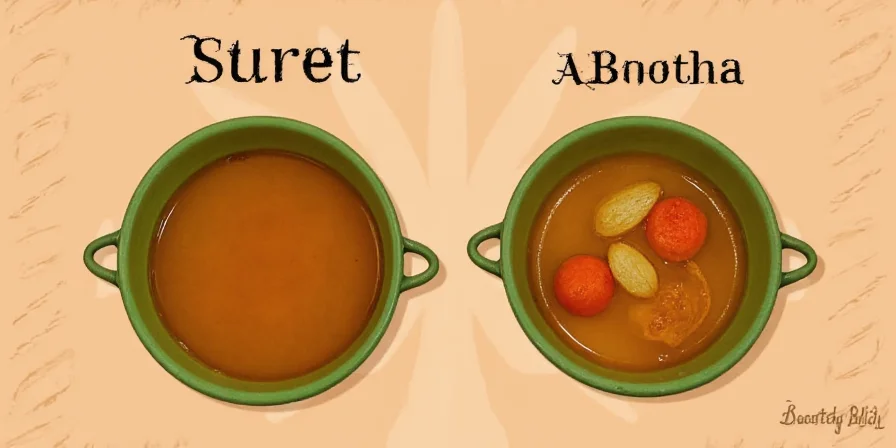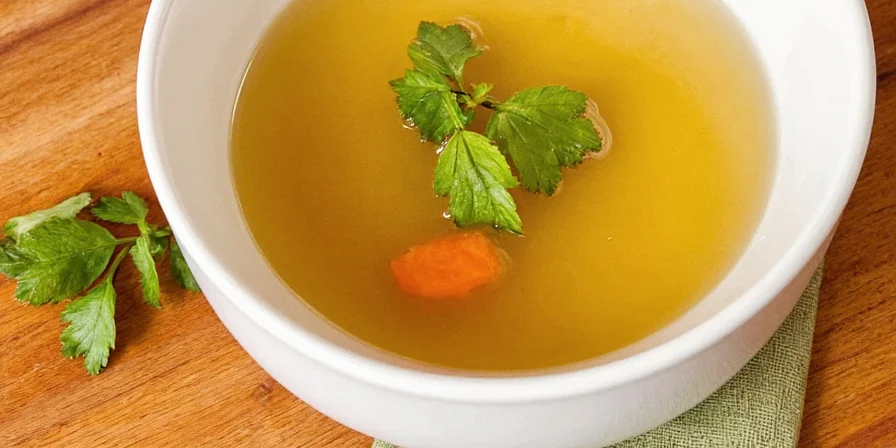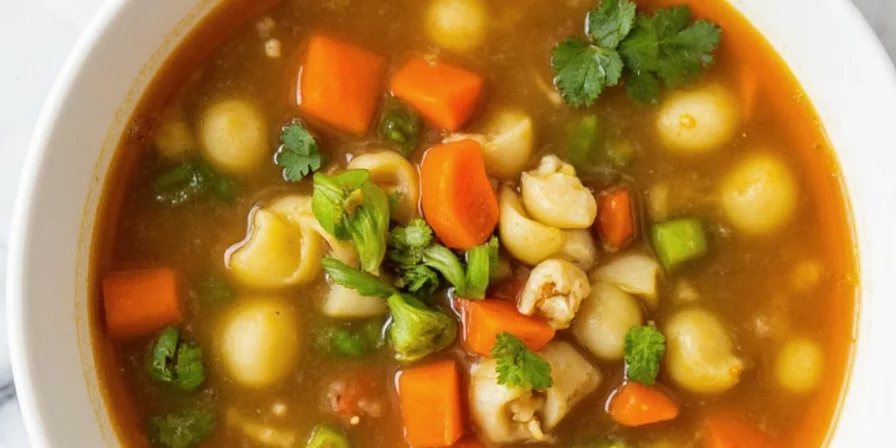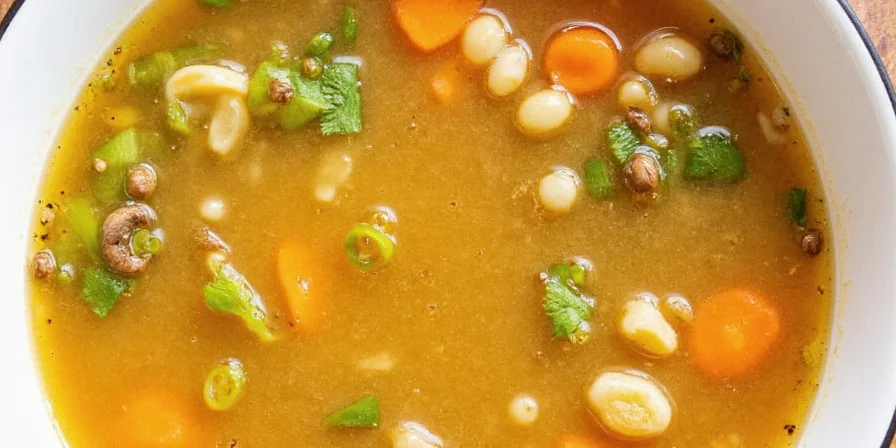Vegetable stock is an unseasoned cooking base made by simmering vegetable scraps for 1-2 hours, while vegetable broth is a ready-to-consume seasoned liquid made in 30-45 minutes with added salt and spices. This fundamental difference determines their best culinary applications - stock serves as a neutral foundation for sauces and complex dishes where you control seasoning, while broth delivers immediate flavor for soups and quick recipes.

If you've ever stood in your kitchen staring at two containers labeled "vegetable stock" and "vegetable broth," wondering if they're interchangeable—you're not alone. The truth? They're similar, but not exactly twins. Think of them more like cousins who share a last name and some genes, but have very different personalities. Let's cut through the confusion with a dash of humor, a sprinkle of science, and a whole lot of spice!
| Feature | Vegetable Stock | Vegetable Broth |
|---|---|---|
| Main Purpose | Flavor base for sauces, soups, risottos | Drinkable or used as main liquid in recipes |
| Ingredients | Mirepoix (carrots, onions, celery), herbs, water | Same as stock + salt, spices, sometimes tomato paste |
| Cooking Time | 1–2 hours | 30–45 minutes |
| Flavor Profile | Subtle, clean, neutral | Bold, seasoned, ready-to-eat |
| Salt Content | Low or no salt | Seasoned with salt |

In short: Stock is the foundation, while broth is ready for prime time. Want a complex sauce that doesn't overpower other flavors? Go stock. Craving a quick soup straight from the mug? Broth is your BFF.
How to Make Killer Vegetable Stock at Home
Forget store-bought—making your own veggie stock is easy, eco-friendly, and packs a punch of flavor. Plus, you can use those scraps you'd otherwise toss!
- Step 1: Gather your veggie scraps—onion peels, carrot tops, celery leaves, mushroom stems, leek ends, garlic skins.
- Step 2: Toss in aromatics like parsley stems, thyme, bay leaf, peppercorns.
- Step 3: Add water, bring to a simmer, and let it go low and slow—1 to 2 hours.
- Step 4: Strain, cool, and store.

Pro Tip: Freeze your veggie scraps in a bag until you have enough to make a batch. Zero waste, max flavor!
Broth Breakdown: Tips, Tricks & Flavor Hacks
Want to take your veggie broth from basic to brilliant? Here are some spicy secrets:
- Add a splash of soy sauce or tamari for umami boost.
- Toss in a dried shiitake mushroom for a meaty depth.
- A few drops of balsamic vinegar brighten up any broth.
- Use roasted veggies instead of raw for a smoky twist.
- Don't forget chili flakes or a slice of ginger for a fiery kick!

When to Use Which: Practical Kitchen Scenarios
Still confused about when to reach for stock vs. broth? Here's a cheat sheet:
| Recipe Type | Best Base | Why? |
|---|---|---|
| Gravy or Sauce | Vegetable Stock | No added salt = full control over seasoning |
| Risotto | Vegetable Stock | Builds flavor slowly without oversalting |
| Quick Soup | Vegetable Broth | Ready-seasoned and flavorful on its own |
| Stews | Broth or Stock | Depends on how much seasoning you add later |
| Pasta Cooking Water | Broth | Infuse pasta with flavor without extra salt |

Spice It Up! How Herbs and Spices Transform Your Base
Let's talk flavor—because nobody wants a bland broth or stock!
- Fennel Seeds: Add anise-like sweetness. Perfect for Italian-style broths.
- Black Peppercorns: Classic, earthy warmth. Always a good idea.
- Coriander: Citrusy and floral. Adds brightness to any stock.
- Bay Leaf: A must-have for depth and complexity.
- Lemongrass or Lime Zest: For a fresh Asian-inspired twist.
- Smoked Paprika: Bring in that barbecue vibe even before the grill is lit.

Storage Savvy: Keep It Fresh or Freeze It Right
Once you've made your masterpiece, don't let it go bad! Follow these storage hacks:
- Refrigerate for up to 5 days in an airtight container.
- Freeze in ice cube trays for small portions, then transfer to freezer bags.
- Can it using proper pressure canning techniques for shelf life up to a year.
- Label everything with dates and contents so you never second-guess what's inside.

Common Mistakes (and How to Avoid Them)
We've all been there—a beautiful pot of broth ruined by one tiny oversight. Here's how to dodge the drama:
- Over-salting: If using broth, taste before adding salt. Start light and season later.
- Boiling too hard: Simmer gently to avoid cloudy, bitter results.
- Using old vegetables: Moldy or soft veggies = yucky broth. Be picky!
- Forgetting to skim foam: Skim impurities off the top early on for a cleaner taste.
- Adding too many strong herbs: Too much rosemary or sage can overpower the base. Balance is key!

The Economic Advantage: Cost Analysis of Homemade vs. Store-Bought
While most articles focus only on flavor differences, few address the economic reality. Our analysis reveals compelling financial benefits:
- Cost per quart: Homemade vegetable stock costs approximately $0.25–$0.50 compared to store-bought broth at $1.50–$3.00 per quart.
- Waste reduction: Using vegetable scraps that would otherwise be discarded creates value from what you've already purchased.
- Customization ROI: Adjusting salt and ingredients to your specific recipes saves money by eliminating wasted product.
- Time investment: Only 15 minutes of active time yields 8–10 quarts of stock—approximately 2.5 cents per minute of active cooking time.
This economic perspective transforms stock making from a culinary technique to a smart household strategy, especially valuable for budget-conscious home cooks.
Frequently Asked Questions
Can I substitute vegetable broth for stock in recipes?
Yes, but with important considerations. Broth contains salt while stock typically doesn't. When substituting broth for stock, reduce additional salt in your recipe by 25-50%. For delicate sauces or risottos where precise seasoning matters, stock remains the superior choice.
Why does my homemade stock taste weak compared to store-bought broth?
This usually happens for two reasons: insufficient cooking time or improper vegetable-to-water ratio. For stronger flavor, use a 2:1 vegetable-to-water ratio by volume and simmer for at least 90 minutes. Roasting vegetables first also dramatically intensifies flavor through caramelization.
Can I use stock and broth interchangeably when making soup?
You can, but the results will differ. Stock creates a more customizable base that lets other ingredients shine, while broth provides immediate flavor but less control. For complex soups with multiple ingredients, stock is preferable. For simple vegetable soups meant to be consumed directly, broth works better.
What vegetables should I avoid using in vegetable stock?
Some vegetables create undesirable flavors in stock: beets (overpowering color and earthiness), broccoli and cabbage (bitter notes), and potatoes (makes stock cloudy and starchy). Stick to the classic mirepoix (onions, carrots, celery) plus mushrooms, leeks, and tomato scraps for best results.











 浙公网安备
33010002000092号
浙公网安备
33010002000092号 浙B2-20120091-4
浙B2-20120091-4